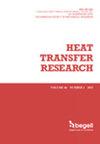Thermal Analysis of a Plate Heat Exchanger (PHE) Fitted with Carding Tool Patterns using CFD Modeling
IF 1.6
4区 工程技术
Q3 THERMODYNAMICS
引用次数: 0
Abstract
Inspired by the wool carding tools, a new plate heat exchanger (PHE) design was developed, tested and analyzed numerically. The present research work used CFD simulations to examine the impact of various parameters, such as the rib type (continuous, discreet), the arrangement type (rectangular, square and triangular) and the geometrical parameters (transversal and longitudinal pitch) on the PHE hydraulic and thermal performances. A three-dimensional 3D evaluation of turbulent flow over a plate fitted with carding tool patterns was conducted using the k-ɛ turbulence model and with a Reynolds number range of 400 to 1800. The numerical results were compared to previous experimental research to validate the dependability of the technique, and a mesh independence analysis was performed to confirm the precision and the accuracy of the CFD method. The results show that CFD software Ansys can effectively predict the pressure drop across the carding tools and provide valuable insights into the fluid flow behavior within the system in terms of calculating the thermal hydraulic performance parameter THPP and the thermal effectiveness ɛ. The ultimate goal of this research work was to identify the ideal arrangement with the highest heat transfer rate and the lowest pressure losses in terms of determining the best THPP. Compared to the conventional PHE chevron type, the thermal performance of the novel PHE design was enhanced by 25.63 % and 54% in terms of non-dimensional parameters ɛ and THPP, respectively.基于CFD模型的梳刀型板式换热器热分析
受羊毛梳理工具的启发,开发了一种新的板式换热器(PHE)设计,并对其进行了测试和数值分析。本研究利用CFD模拟研究了肋型(连续型、离散型)、布置型(矩形型、正方形型和三角形型)和几何参数(横向节距和纵向节距)等参数对PHE水力和热性能的影响。采用k- ε湍流模型,在雷诺数400 ~ 1800范围内,对带有梳理工具图案的平板湍流进行了三维评价。将数值计算结果与以往的实验研究结果进行了对比,验证了该方法的可靠性,并进行了网格无关性分析,验证了CFD方法的精密度和准确性。结果表明,CFD软件Ansys可以有效地预测梳理工具的压降,并通过计算热工性能参数THPP和热效率系数,为系统内流体流动行为提供有价值的见解。本研究工作的最终目标是在确定最佳THPP时,确定具有最高传热率和最低压力损失的理想布置。与传统的花式PHE相比,新型设计的花式PHE在无因次参数和THPP方面分别提高了25.63%和54%。
本文章由计算机程序翻译,如有差异,请以英文原文为准。
求助全文
约1分钟内获得全文
求助全文
来源期刊

Heat Transfer Research
工程技术-热力学
CiteScore
3.10
自引率
23.50%
发文量
102
审稿时长
13.2 months
期刊介绍:
Heat Transfer Research (ISSN1064-2285) presents archived theoretical, applied, and experimental papers selected globally. Selected papers from technical conference proceedings and academic laboratory reports are also published. Papers are selected and reviewed by a group of expert associate editors, guided by a distinguished advisory board, and represent the best of current work in the field. Heat Transfer Research is published under an exclusive license to Begell House, Inc., in full compliance with the International Copyright Convention. Subjects covered in Heat Transfer Research encompass the entire field of heat transfer and relevant areas of fluid dynamics, including conduction, convection and radiation, phase change phenomena including boiling and solidification, heat exchanger design and testing, heat transfer in nuclear reactors, mass transfer, geothermal heat recovery, multi-scale heat transfer, heat and mass transfer in alternative energy systems, and thermophysical properties of materials.
 求助内容:
求助内容: 应助结果提醒方式:
应助结果提醒方式:


